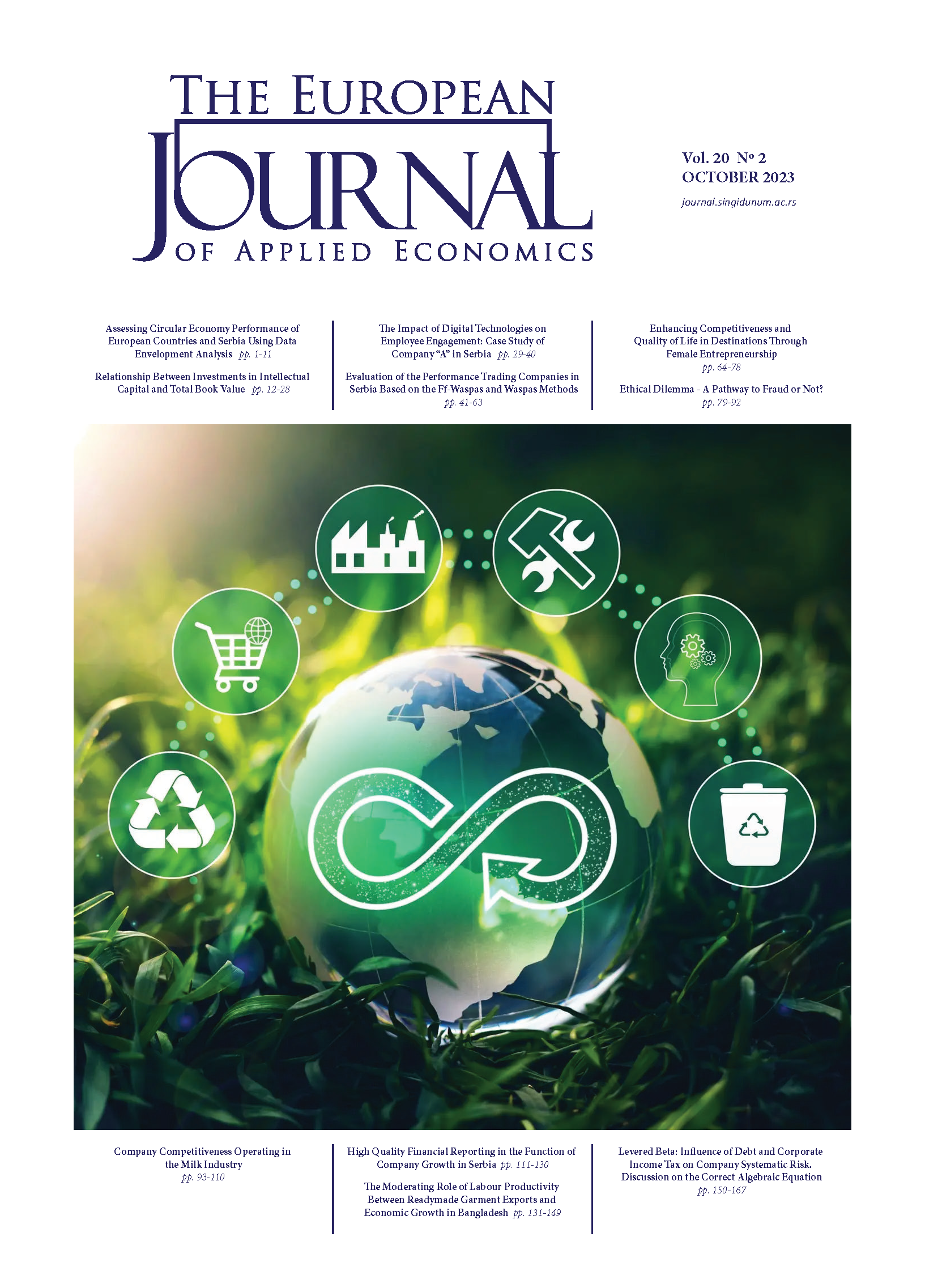ASSESSING CIRCULAR ECONOMY PERFORMANCE OF EUROPEAN COUNTRIES AND SERBIA USING DATA ENVELOPMENT ANALYSIS
Abstract
The circular economic system concentrates on closing the loop for resource flows by imitating the function of natural ecosystems in order to achieve sustainability. The purpose of this study is to present a comprehensive approach to assessing countries' performance in municipal waste management and utilization. This paper assessed the change in the efficiency of circular economy performance over the period of four years, from 2016 until 2019. In the first stage, output-oriented DEA model with a variable return to scale has been applied, while in the second stage Tobit regression model examined the influence of macroeconomic factors on achieved efficiency scores. Results show that the performance of the circular economy has an enviable level of efficiency since the average score is above 70%. Belgium, Lithuania, Poland and Sweden achieved extremely high-efficiency levels during the whole time frame. Countries with the lowest efficiency scores are Greece and Cyprus. The positive conclusion is that countries efficiency mainly has an ascending trend. Furthermore, the second stage analysis showed that resource productivity, private investments, jobs and gross value added related to the circular economy sector and GDP per capita significantly influence the efficiency of circular economy performance.
References
Agovino, M., D`Uva, M., Garofalo, A., & Marchesano, K. (2018). Waste management performance in Italian provinces: Efficiency and spatial effects of local governments and citizen action. Ecological Indicators, 89, 680-695. DOI: https://doi.org/10.1016/j.ecolind.2018.02.045
Banker, R. D., Charnes, A., & Cooper, W. W. (1984). Some Models for Estimating Technical and Scale Inefficiencies in Data Envelopment Analysis. Management Science, 30(9), 1078-1092.
Bianchi, M., & Cordella, M. (2023). Does circular economy mitigate the extraction of natural resources? Empirical evidence based on analysis of 28 European economies over the past decade", Ecological Economics, 203.
Busu, M. (2019). Adopting Circular Economy at the European Union Level and Its Impact on Economic Growth. Soc. Sci. 2019, 8, 159. [Google Scholar] [CrossRef][Green Version]
Cameron, C., & Trivedi, P. (2005). Microeconometrics. Cambridge University Press
van Capelleveen, G.; Amrit, C.; Zijm, H.; Yazan, D.M.; Abdi, A. (2021). Toward Building Recommender Systems for the Circular Economy: Exploring the Perils of the European Waste Catalogue. J. Environ. Manag. 2021, 277
Chen, C.C. (2010). A performance evaluation of MSW management practice in Taiwan. Recources, Conservation and Recycling, 54(12), 1353-1361. DOI: 10.1016/j.resconrec.2010.05.003
Charnes, A., Cooper, W. W., & Rhodes, E. (1978). Measuring the efficiency of decision making units. European journal of operational research, 2(6), 429-444. DOI: 10.1016/0377-2217(78)90138-8
Cooper, W., Seiford, L., & Tone, K. (2007). Data Envelopment Analysis. Springer
Corvellec, H., Ek, R., Johansson, N., Svingstedt, A., Zapata, P., & Zapata Campos, M. (2018). Waste prevention is about effective production and thoughtful consumption – not about waste. https://portal.research.lu.se/portal/files/64572692 (Accessed November 10, 2022)
de Leonardis F. (2011). The legal provisions governing waste in the Italian legal system, IUS Publicum Network Review, 1, Annual Report-2011-Italy.
Emrouznejad, A., & Yang G. (2018). A survey and analysis of the first 40 years of scholarly literature in DEA: 1978–2016. Socio-Economic Planning Sciences, 61(1), 4-8. DOI: https://doi.org/10.1016/j.seps.2017.01.008
Fan, Y., Fang, C. (2020). Circular economy development in China-current situation, evaluation and policy implementations. Environmental Impact Assessment Review, 84, 106441. DOI: https://doi.org/10.1016/j.eiar.2020.106441
Garcia Barragan, J., Eyckmans, J., Rousseau, S. (2019). Defining and measuring the circular economy: a mathematical approach. Ecological Economics, 157(2019), 369-372. DOI: https://doi.org/10.1016/j.ecolecon.2018.12.003
Ghisellini, P., Cialani, C., Ulgiati, S. (2016). A review on circular economy: the expected transition to a balanced interplayof environmental and economic systems. Journal of Cleaner Production, 114(1), 11-32. DOI: https://doi.org/10.1016/j.jclepro.2015.09.007
Giannakitsidou, O., Giannikos, I., & Chondrou, A. (2020). Ranking European countries on the basis of their environmental and circular economy performance: A DEA application in MSW. Waste Management, 109(1), 181-191. DOI: https://doi.org/10.1016/j.wasman.2020.04.055
Greene, W.H. (2003). Econometric Analysis: Fifth Edition. Prentice Hall, New Jersey
Halkos, G., Papageorigiou, G. (2016). Spatial environmental efficiency indicators in regional waste generation: a nonparametric approach. Journal of Environmental Planning and Management, 59(1), 62-78. DOI: https://doi.org/10.1080/09640568.2014.983592
Jacobi, N., Haas, W., Wiedenhofer, D., Mayer, A. (2018). Providing an economic-wide monitoring framework for the circular economy in Austria: status quo and challenges. Resources, Conservation and Recycling, 137(2018), 156-166. DOI: https://doi.org/10.1016/j.resconrec.2018.05.022
Korhonen, J., Honkasalo, A., Seppala, J. (2018). Circular economy: the concept and its limitations. Ecological Economics, 143(2018), 37-46. DOI: https://doi.org/10.1016/j.ecolecon.2017.06.041
Lacko, R., Hajdukova, Z., Zawada, M. (2021). The Efficiency of Circular Economies: A Comparison of Visegrád Group Countries. Energies 2021, 14(6), 1680
Marcikić Horvat A., Milenković N., Radovanov B., Zelenović V., Milić D. (2022). DEA Efficiency of Serbian Banks- Comparison of three Approaches. Journal The Annals of the Faculty of Economics in Subotica, online first. https://doi.org/10.5937/AnEkSub2200011M
Milenković, N.; Radovanov, B.; Kalaš, B.; Horvat, A.M. External Two Stage DEA Analysis of Bank Efficiency in West Balkan Countries. Sustainability 2022, 14, 978. https://doi.org/10.3390/su14020978
Popović A., Ivanović Đukić M., Milijić A. (2022). Assessment of the impact of Circular Economy competitiveness and innovation on European economic growth. The European Journal od Applied Economics, 19 (2), 1-13. DOI: 10.5937/EJAE19-39057
Sun, J., Li, G., Wang, Z. (2019). Technology heterogeneity and efficiency of China`s circular economic systems: a game meta-frontier DEA approach. Resource, Conversation and Recycling, 146(1), 337-347. DOI: https://doi.org/10.1016/j.resconrec.2019.03.046
Van Fan, Y., Lee, C., Lim, J., Klemeš, J., Le, P. (2019). Cross-disciplinary approach towards smart, resilient and sustainable circular economy. Journal of Cleaner Production, 232(2019), 1482-1491. DOI: https://doi.org/10.1016/j.jclepro.2019.05.266
William W. Cooper, W., Seiford, L., Tone, K. (2007) Data Envelopment Analysis. Springer
Winans, K., Kendall, A., Deng, H. (2017). The history and current applications of the circular economy concept. Renewable and Sustainable Energy Reviews, 68(1). 825-833. DOI: https://doi.org/10.1016/j.rser.2016.09.123
https://www.epa.gov/recyclingstrategy/what-circular-economy
https://www.oecd.org/cfe/cities/InventoryCircularEconomyIndicators.pdf


